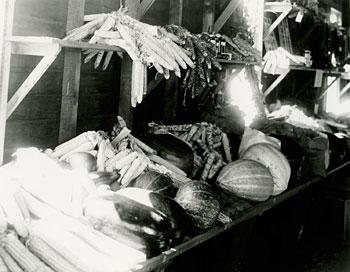
Vegetable exhibit at Standing Rock Fair, Fort Yates, ND
SHSND# 1952-0577Morton County fair supervisors went through several arrangements of the garden vegetable exhibit. The earliest category was Vegetables and Fruits. In 1904, the category changed to Vegetables and Fodder and included in addition to garden vegetables fodder (field) corn, alfalfa, and other feedstuffs such as artichokes and charlottes (as far as I can tell, a type of waxy potato). In 1917, the category changed once again to Farm and Garden Products with separate classes for garden vegetables and another for fruit. By this time, the vegetables were also organized into very specific categories with red and yellow tomatoes, red, yellow, and white onions, etc. In all, there were 45 entry categories for vegetables in the 1921 fair, an increase over the thirty categories in 1895.
American Indians were encouraged to enter their garden products separately in the Indian Division, a subdivision of the Woman’s Department, from 1895 to 1930. There was a single category for vegetables and a single category for jelly in the Indian Division.
Most of the vegetable categories were typical of garden produce: potatoes (red and white), cabbage (early and winter), cauliflower, lettuce, celery, rhubarb, salsify, eggplant, radishes (early and winter), peppers, beets, string beans, turnips, onions (red and yellow), tomatoes, carrots, parsnips, lima beans, peas, muskmelons, watermelons, winter squash, and pumpkins.




